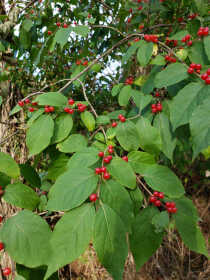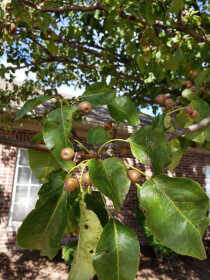Invaders in our landscape: Invasive plants to watch for in the fall
Leaves have started changing all around us, but there are some invaders in our landscape.
These invaders are native to a different part of the world but have been happily making our forests and back yards their homes at the expense of our songbirds, gamebirds and reptiles. They often have green leaves after our native plants, which means less sunlight for our reptiles. They also produce fruit or berries that don’t provide the same nutrition as our natives nor as much cover, leaving our birds more vulnerable in the winter.
Fall is a great time to identify these invaders and work to remove them from our landscape. The most common method is to cut the stems of the plants close to the ground, then treat the stump with an herbicide to prevent regrowth.
If herbicide is not available or is undesirable, the stems can still be cut close to the ground. Regrowth will likely occur and plants will need cut again in these circumstances.
Here are the top five invaders that are easily identified in fall:

1. Burning bush (euonymus alatus) - Although once a popular landscape plant, Burning Bushes are known for their brilliant red fall color and can now be seen in wooded areas. Most Burning Bush stems have “wings” of corky material that run the length of or slowly twist around the stem.

2. Asian bush honeysuckle (Lonicera spp.) - At this time of year, the red berries can be seen among the leaves that are opposite each other on the stems. Certain types of Asian bush honeysuckle are associated with higher levels of predation for birds and other wildlife due to differences in plant structure.

3. Bradford pear or callery pear (pyrus calleryana) – Another popular landscape plant, the callery pear has white flowers in the spring, but often has roughly marble sized fruit that develop in the fall. This fruit is too small for people to eat but can be consumed by some animals and then spread through droppings. Plants that have spread into the wild may have small thorns present. Once the trees get larger, the weak branch structure can cause limbs to fall when laden with snow or ice.

4. Wintercreeper (euonymus fortune) – Wintercreeper is an aggressive vine that stays green all winter. The leaves are a glossy, dark green and the vines creep up trees, buildings or whatever is in their path. Vines that have been growing up may have small, whitish berries that have orange pulp. Birds may eat the berries and help the plant spread.

5. Multiflora rose (rose multiflora) – Multiflora rose can grow to 15 feet tall on arching canes. It has 7-9 leaflets on each leaf. Rose hips may be present this time of year. The major distinguishing factor from other roses is the fringed petioles, or the part that attaches the leaflets to the stem or cane.
There is a group in the county made up of volunteers that works to educate about and eradicate invasive species called Putnam County – Remove Invasive Plants, or PC RIP. They hold monthly meetings and often hold Weed Wrangles at various locations around the county. For more information on invasive plants or the PC RIP group, reach out to the Purdue Extension-Putnam County at 653-8411 or the Putnam County Soil & Water Conservation District at 653-5716, ext. 3.
